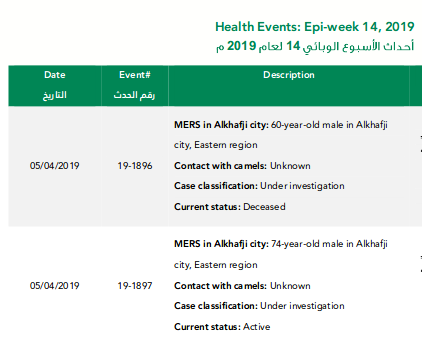#13,984
A week ago the Saudis announced a single, primary (with camel contact) MERS case (M,75) in Al Khafji, very near the Saudi border with Kuwait. Yesterday they announced a cluster of 3 secondary cases - one of whom was already deceased - in the same town.
Today, the MOH is reporting two more cases (one deceased) from Al Khafji , both of which are currently listed as `under investigation'. As with the previous 4 cases, all are older males.At this time, we have no indication of the source of their exposure, or what epidemiological links - if any - today's cases may have had with the other cases.
It's always a worrying sign when we see cases announced after the patient's death, as it suggests testing, diagnosis, and isolation may have been delayed, increasing the chances of additional exposures.
MERS infections can range from asymptomatic or mild, to severe and often deadly. Symptoms can vary widely, and may not always include respiratory symptoms, making diagnosis difficult (see J. Korean Med Sci: Atypical Presentation Of A MERS Case In A Returning Traveler From Kuwait).
MERS lab tests aren't 100% accurate either, and it generally requires two negative tests - 48 hours apart - to exclude MERS-CoV as a diagnosis (see AJIC:Intermittent Positive Testing For MERS-CoV).Last August - in Evaluation of a Visual Triage for the Screening of MERS-CoV Patients - we looked at a highly critical review of the screening methods used by the Saudis for selecting patients for MERS testing. The authors were particularly blunt in their assessment (bolding mine) of the current system.
The current study conducted on a large number of patients shows that clinical scoring is not predictive of MERS infection.
Our results are robust and confirm that MERS cannot be distinguished from other respiratory infections based on risk factors and clinical features. Thus all patients with non-specific symptoms in a MERS endemic area will have to be isolated until MERS can be ruled out by rapid PCR testing.Direct or indirect camel contact is often cited as a source of primary (community acquired) MERS infection - but in roughly half these community acquired cases their source of infection is never identified.
This has raised concerns that unidentified mildly ill - or potentially even asymptomatic cases - may be spreading the virus, albeit inefficiently, in the community.The good news is - so far we've seen no signs of any sustained or efficient transmission of the MERS virus outside of some healthcare facilities and and a few households.
The big unknown, of course, is that the MERS virus continues to evolve and adapt - and while it may not be equipped to spark a pandemic today - there are no guarantees about tomorrow.

